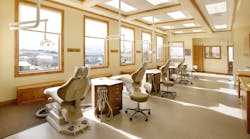Designing the dental practice of the future: Operatory design for air quality and aerosol containment (pt. 4)
It seems like a simple choice: walls or no walls. Open and closed operatories each come with their own set of pros and cons, but COVID-19 has created new concerns about air quality and aerosol containment that add additional considerations for approaching operatory design. Deciding which one might yield the healthiest environment for your patients and team members means adopting an all-encompassing view of quality of life at work.
Open versus closed
When it comes to infection control, air quality and office design should work hand-in-hand to create a safe environment. Recognizing the link between the two begins with understanding some key concepts of dental operatory layouts, including the history, benefits, and shortcomings. Defining what is meant by an “open” or “closed” operatory is a good place to start.
Operatories confined by four walls are considered “closed;” some have a single entry for patients and practitioners, and others have dual entry. This dual entry concept, pioneered by the late dental innovator Dr. James Pride,1 allows assistants to enter and exit the room at their ideal position near the patient’s shoulder, without having to squeeze behind the head of the chair or walk down and around the toe. Some closed operatories, whether dual or single entry, use doors for complete privacy, while others contain simple openings for easy in-and-out.
“Open” operatories use cabinetry instead of walls to define each space, and are often sought for a lighter, more casual feel. Introduced in the 1970s, this style grew in popularity over the next two decades as more manufacturers moved into the cabinetry business, integrating equipment into furniture. Open operatory cabinetry has evolved to become modern and airy with sophisticated center islands featuring pass-through cabinets, shared sinks, and a space-saving footprint. Some might argue that the creation of this sleek open concept makes closed operatories seem dated and claustrophobic.
The problem with open ops
Even before the first airborne infectious disease pandemic plagued the dental industry, open operatories began to present challenges. As a designer, it reminds me of the evolution of the American workplace: The hard-wall office once reigned supreme, but it was replaced by the cubicle upon its invention in the 1960s, and within the last decade, the cubicle gave way to hip, low-slung open workstations. Open office designs that first seemed like a novel way to introduce more natural light, conserve space, promote collaboration, and save on traditional construction were dubbed a “disaster” by the Chicago Tribune in 2018, with American workers feeling distracted, unproductive, and imposed upon.2
The lesson? To do our best work, we need spaces that properly support our needs and activities, including deep thinking, focus, and concentration. These needs may evolve over time, and design should evolve along with them. In health-care design, this concept should be applied and then taken one step further to consider patients’ needs as well. What do they need to feel comfortable, safe, and supported?
The biggest problem that arose from the invention of open operatories stems from acoustics. Open spaces tend to be louder, which affects concentration and communication. Team-to-team conversations aside, noise can make it difficult for patients to hear and understand their treatment plan and aftercare instructions. An open environment can also leave patients feeling vulnerable and exposed, especially when uncomfortable or in pain. Very few health-care disciplines outside of dentistry utilize open designs for these reasons. Now, with the nation experiencing heightened concern about airborne infection transmission, open treatment spaces may create further unease.
Containing contaminated air
Airborne considerations add another layer of complication to open operatory design. Currently, there is no evidence that links SARS-CoV-2 outbreaks more to open versus closed dental office designs.3 However, the Centers for Disease Control and Prevention still recommend that patients with known or suspected SARS-CoV-2 be treated in an individual patient room with a closed door.4 In the field of health-care design, we know that closed spaces make it easier to contain and treat contaminated air, whether through negative pressure isolation (where air is contained and exhausted safely out of the building) or filtration and recirculation (where air passes through medical-grade HEPA filters, sometimes in combination with UV lights, before being redistributed). Airborne infection isolation rooms (AIIRs), used in hospitals to treat airborne infectious patients, are well sealed to prevent air leakage. Applying these principles to the dental environment makes a compelling case for closed operatories. And, adding doors can actually be a design-booster, not a deterrent. In dual-entry scenarios, barn doors on the doctor’s side and pocket doors on the assistant’s side look great and take up minimal floor space.
Integrating air purification techniques
Whether open or closed, there are air quality techniques that can be integrated into a practice’s operatory design for infection control and safety. While AIIRs may be overkill—and cost-prohibitive in dentistry—HVAC enhancements, air purification systems, and extraoral suction devices can help control the spread of contaminants.
Air purification systems can be grouped into two categories: those that integrate with the building’s existing HVAC system or infrastructure, and those that are freestanding or wall-mounted. HVAC-integrated systems, such as the LifeAire Aire~BioLite System, are beneficial in that they don’t take up valuable operatory real estate, are quiet, and require little to no maintenance. The VidaShield UV24, another unobtrusive solution, is an overhead ceiling light with integrated air purification. Freestanding systems, such as the EnviroKlenz Mobile Air System, plug into the wall as easily as a toaster and get to work immediately, filtering infectious particles and odors alike.
When it comes to extraoral suction, the most exciting system I’ve seen comes from Nederman, a longtime player in the industrial air filtration space. They applied proven industrial-strength technology to the dental industry, creating a powerful extraoral suction arm that mounts to the ceiling to free-up floor space and articulate with ease.
The case for air quality
We’re all tired of hearing, talking, and reading about the pandemic, so thinking about air quality in your office may seem eye-roll worthy. I get it. COVID-19 aside, air quality is an important design consideration for overall health and well-being. The dental environment is especially prone to indoor chemical pollutants—methanol, propanol, and formaldehyde, to name a few—that are biproducts of the materials and substances used for dental procedures, the cleaning agents used for disinfection, and the particles released during grinding and polishing. These impurities, called volatile organic compounds (VOCs), settle into our bodies when we breathe them in, and can create both temporary and long-term adverse health effects. Eye, nose, and throat irritation, headaches, fatigue, dizziness, visual disorders, and memory impairment are just a few VOC-induced symptoms cited by the Environmental Protection Agency.5 Integrating air purification into your office design can address indoor pollutants and unpleasant odors just as they can infectious diseases. While your aim is to create healthy smiles, as a health-care interior designer, I aim to create healthy buildings, and I hope that by joining these concepts together, we can create a better dental environment for you, your staff, and your patients.
REFERENCES
1. Pride Institute. https://www.prideinstitute.com/about-pride/
2. Pochepan J. The open office plan is a disaster. Chicago Tribune. February 20, 2018. https://www.chicagotribune.com/business/success/tca-the-open-office-plan-is-backfiring-20180220-story.html
3. Open operatory dental setting infection control practices and risk of transmission during aerosol-generating dental procedures. Public Health Ontario Rapid Review. November 26, 2020. https://www.publichealthontario.ca/-/media/documents/ncov/ipac/2020/11/open-operatory-dental-ipac-aerosol-procedures.pdf?la=en
4. CDC Guidance for dental settings. Updated December 4, 2020. https://www.cdc.gov/coronavirus/2019-ncov/hcp/dental-settings.html
5. Volatile organic compounds’ impact on indoor air quality. United States Environmental Protection Agency. https://www.epa.gov/indoor-air-quality-iaq/volatile-organic-compounds-impact-indoor-air-quality
Editor's note: This article is part four in a five-part series. Related articles can be found here:
Benco director of design MELISSA SPRAU, NCIDQ, brings over a decade of commercial and hospital design experience to the dental industry. As a licensed interior designer with a background in health-care facilities planning and design, her approach combines best practices for health and safety with the details required to support positive patient and caregiver experiences. Sprau coaches practitioners to discover their brand and infuse it into the built environment, aligning quality of space with quality of care.






